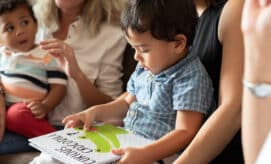Developing strong foundational literacy skills during early childhood sets children up for long-term learning and academic success. Early learning professionals play an important role in helping young children build the early literacy skills, such as phonics and reading comprehension, that will help them thrive, both inside and outside of the classroom. In this article, we explore the five elements of early literacy, and offer research-based tips for incorporating all five during your program’s storytime.
5 Key Components of Early Literacy
In 2010, the National Institute of Child Health and Human Development issued a publication examining the instructional practices used with children from birth through age five to support emerging literacy skills. The report pointed to research identifying five critical areas that comprise effective reading instruction:
- Phonemic Awareness is the ability to notice and identify the many different sounds that are part of our speech. Phonemes are the smallest units of sound in a language, such as the sound the letter “t” makes in the word “talk.” Phonemic awareness is noticing the “t” sound in a word, and recognizing that the same sound appears in other words.
- Phonics refers to the process of connecting sounds of spoken speech to written letters. For example, young children are demonstrating phonics skills when they hear the word “dog” and can identify that the letter “D” represents the sound at the start of the word.
- Fluency is a more complex literacy skill, that describes the ability to read accurately and quickly. When children become fluent readers, they can read out loud naturally and with expression, as if they are speaking.
- Vocabulary is the collection of words we must know to understand what we hear and read, as well as to communicate with others.
- Comprehension is the ability to hear language, take in the information, and make meaning of what we have heard. This is demonstrated when a child listens to a story for understanding, and then talks about the story with others.
The 5 Components of Early Literacy are Building Blocks for Success in Kindergarten and Beyond
A growing body of research on reading development, which is commonly referred to as “The Science of Reading,” explores how our brains learn to read. The research shows that focusing on building children’s literacy skills from a young age helps to create a strong foundation for reading and a path toward academic success.
An article written by Lynne Hall, a former preschool educator and research associate at Indiana University who holds a Master of Science in Education, explains “Rigorous studies have consistently shown that systematic phonics instruction, coupled with explicit instruction in other key components of literacy improve reading outcomes for all students, regardless of background or ability level…By prioritizing evidence-based practices and providing children with the support they need to develop strong foundational reading skills, we can unlock a world of opportunities for them.”
With an understanding of each of these core literacy skills, early learning professionals and care providers can create learning environments and activities that help little ones get a strong start in early literacy.
Research-based Strategies to Support Early Literacy
In early learning classrooms, storytime is an ideal opportunity to incorporate early literacy skills in meaningful and engaging ways. Below you’ll find research-based strategies for all five key literacy skills that can easily be woven into your program’s storytime. You might notice that many of these are things that you already do naturally with the little ones in your care!
Read Rhyming Books
Rhyming children’s books include predictable patterns and repeated sounds that help children recognize different speech sounds and begin to distinguish between words that sound similar but have different meanings. In this way, rhyming stories help to build and strengthen phonemic awareness.
While reading rhyming books with the children in your care, you might read a line or two and encourage the children to repeat it back to you, almost like a song. When reading Dr. Seuss’s One Fish, Two Fish, for example, you could invite the children to notice that several different words sound very similar, and then point out the book’s rhyming words – such as “two,” “blue,” and “new.”
Offer a Variety of Books
There are so many engaging children’s books that feature different characters, themes, words, and stories. Having a variety of different kinds of books available in your learning space is a great way to help build children’s vocabulary and literacy skills.
An article from the Illinois Learning Project explains, “A variety of books for read-aloud time is critical for teaching vocabulary. Books with characters that are different culturally or in other ways than the children in your class can expose children to new words and increase their vocabulary more than the everyday language they use in their homes and at school. What about a book about farm life, if your school is in the city, or a book about the animals of South America, or a book about working at the post office? All these books are going to expose your students to new words that you can define and talk about, leading to a bigger vocabulary for each child.”
Encourage Children to Read Along With You
During storytime, it can be helpful to encourage little ones to sit close to you so they can watch as you use your finger to follow along with the words that you are reading. You might also pause as you read, to point out different words by sounding out each letter. This helps little learners become familiar with the connection between letters they see on the page and specific sounds – helping to introduce foundational phonics skills.
You can invite older preschoolers to practice putting sounds together. For example, if you are reading the word “bat,” you might say, “This word has three letters: b, a, and t, let’s sound them out…ba…ah..t. What word could that be?”
Turn Reading into a Conversation
As you read a story with children, you can engage them through your facial expressions and tone of voice. You might ask them what they think a character will do next, or predict what they will find on the next page.
With older preschoolers and children in pre-k, you can introduce some simple exercises and questions throughout the story that will offer opportunities to practice their reading comprehension skills. For example, at the end of a story, you might ask questions about the characters in the book, what they did, what they might have been thinking, and more. This helps children to practice taking in the story by noticing details, processing the events in the plot, and then recalling the information that they learned from the story.
Reread Favorite Books
In many early learning classrooms, there are favorite stories that little ones want to read over and over again. While introducing new stories is beneficial, rereading favorite books also provides a rich learning experience for young children.
Rereading supports important early literacy skills, including fluency and comprehension, as little ones build on their previous knowledge of the book’s story, language, and vocabulary, helping them to become more comfortable with the words, and giving them multiple opportunities to take in the plot and characters in the story. You might even notice that some of the children in your care are able to memorize their favorite stories! This means they are becoming increasingly comfortable with the book’s language and rhythm, and are more likely to remember and use the story’s vocabulary words.
Printable Literacy Resources for Educators





